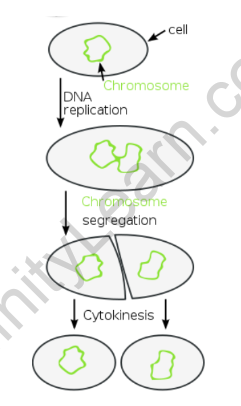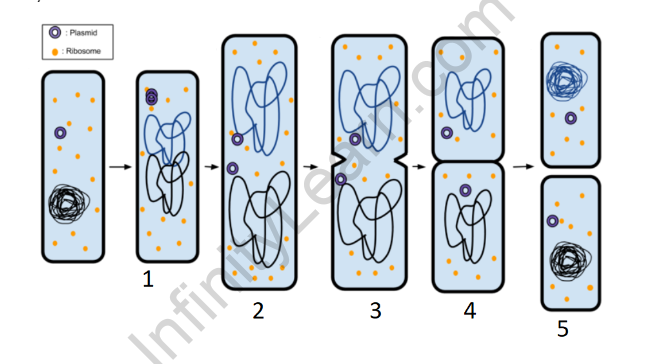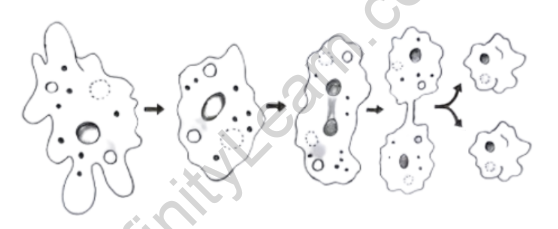Table of Contents
Introduction
Binary fission is a form of asexual reproduction in which an organism divides into two equal-sized daughter cells. This method is commonly observed in single-celled organisms such as bacteria and protists. The parent cell duplicates its genetic material and then divides into two identical daughter cells.

Binary fission is a form of asexual reproduction commonly observed in single-celled organisms, such as bacteria and some protists. It is a process by which a parent cell divides into two identical daughter cells. During binary fission, the parent cell undergoes replication of its genetic material, followed by division of the cell into two equal parts. Each daughter cell receives a copy of the parent’s genetic material, ensuring genetic continuity. The division occurs through the constriction of the cell membrane and the synthesis of a new cell wall or membrane between the two daughter cells. Binary fission allows for rapid population growth and the production of genetically identical offspring, ensuring the propagation of successful traits in stable environments.
In binary fission, the entire process, from replication to cell division, is usually relatively quick and efficient. It does not involve the formation of specialized reproductive structures or the fusion of gametes. The genetic material is replicated and distributed equally, ensuring that each daughter cell inherits the full complement of genes from the parent cell. This form of reproduction is advantageous for single-celled organisms living in favorable environments, as it allows for rapid multiplication and colonization. However, binary fission results in limited genetic diversity, which can limit the ability to adapt to changing conditions and makes populations susceptible to environmental challenges and the spread of harmful mutations.
Binary fission in Bacteria
Binary fission is the primary method of reproduction in bacteria. It is a process by which a single bacterial cell divides into two identical daughter cells. Here’s a brief description of binary fission in bacteria

Replication: Before binary fission, the bacterial cell undergoes replication of its genetic material. The circular DNA molecule present in the cell is duplicated, ensuring that each daughter cell receives a copy of the genetic material.
Cell Elongation: Following DNA replication, the bacterial cell elongates as it prepares for division. The cell wall and membrane components also increase to accommodate the division process.
Septum Formation: As the cell elongates, a septum, or a partition, starts forming at the midpoint of the cell. This septum grows inward, eventually dividing the cell into two separate compartments.
Cell Division: The septum continues to grow until it completely separates the two daughter cells. Each daughter cell obtains a copy of the replicated DNA and other cellular components.
Completion: Once the septum is fully formed, the two daughter cells are released, becoming independent bacterial cells capable of their own growth and reproduction.
Binary fission in bacteria is a rapid and efficient process, allowing for exponential population growth. Since the daughter cells are genetically identical to the parent cell, binary fission maintains the genetic continuity of the bacterial population. However, the lack of genetic diversity resulting from this method of reproduction can limit bacterial adaptation to changing environments and make them susceptible to environmental challenges and the effects of mutations.
Binary fission in Amoeba
Binary fission is a common mode of reproduction in Amoeba, a single-celled organism belonging to the group of protozoans. Here’s a brief description of binary fission in Amoeba

Cell Growth: During binary fission in Amoeba, the parent cell undergoes a period of growth and nourishment to prepare for reproduction. It takes in nutrients and energy from its environment to support the upcoming division process.
Nucleus Division: Amoeba has a single nucleus, which replicates its genetic material through DNA synthesis. The replicated chromosomes then separate, forming two identical sets of genetic material.
Cell Division: Once the nucleus has divided, the cell undergoes cytoplasmic division. The cell membrane starts to constrict in the middle, creating a furrow or cleft.
Cytokinesis: As the furrow deepens, it eventually divides the cytoplasm into two separate portions, each containing a set of chromosomes. This leads to the formation of two daughter cells, which are genetically identical to each other and to the parent cell.
Completion: After the division is complete, the two daughter cells separate from each other and become independent entities capable of their own metabolic activities and reproduction.
Binary fission allows Amoeba to multiply rapidly, increasing its population size under favorable conditions. The process of binary fission in Amoeba is continuous, meaning that each newly formed daughter cell can repeat the cycle of growth, division, and independent existence. This mode of reproduction ensures the genetic continuity of Amoeba, as the daughter cells inherit the same genetic material as the parent cell.
FAQs on Binary Fission
What is an example of binary fission?
An example of binary fission is the reproduction of bacteria, such as Escherichia coli (E. coli), where a single bacterial cell divides into two identical daughter cells.
What is binary fission in biology?
Binary fission in biology refers to a type of asexual reproduction where a single parent organism divides into two daughter cells, each containing a copy of the parent's genetic material. It is a common form of reproduction in various organisms, including bacteria, protists like Amoeba, and some other single-celled organisms.
What is binary vs transverse fission?
Binary fission and transverse fission are essentially the same process, and the terms are often used interchangeably. Both refer to a form of asexual reproduction where an organism divides into two daughter cells. Binary fission is a more general term used for various organisms, while transverse fission specifically refers to the division occurring at a right angle to the longitudinal axis of the organism.
Is binary fission asexual?
Yes, binary fission is a type of asexual reproduction. It involves the division of a single parent organism into two daughter cells without the involvement of gametes or the fusion of genetic material from two parents.
What is transverse and longitudinal fission?
Transverse fission refers to the division of an organism at a right angle to its longitudinal axis. Longitudinal fission, on the other hand, refers to the division occurring parallel to the organism's longitudinal axis.
Is transverse fission asexual?
Yes, transverse fission is a form of asexual reproduction. It results in the formation of new individuals without the involvement of sexual reproduction mechanisms.
Is the Amoeba longitudinal or transverse?
Amoeba reproduces through binary fission, which can be considered both longitudinal and transverse. During binary fission, the parent Amoeba cell divides into two daughter cells, and the division can occur both along the longitudinal axis (lengthwise) or transverse to it.
What is an example of transverse fission?
An example of transverse fission is the reproduction of flatworms, such as planarians. These organisms can divide transversely, creating two daughter individuals with distinct anterior and posterior ends.
Is Amoeba a transverse fission?
Amoeba reproduces primarily through binary fission. While binary fission can occur both longitudinally and transversely it is not specifically referred to as transverse fission in the context of Amoeba reproduction.
What are the three types of fission?
The three types of fission are binary fission, multiple fission, and fragmentation. Binary fission involves the division of an organism into two daughter cells, multiple fission involves the division into multiple daughter cells, and fragmentation refers to the breaking of an organism into multiple fragments, each capable of growing into a new individual.







